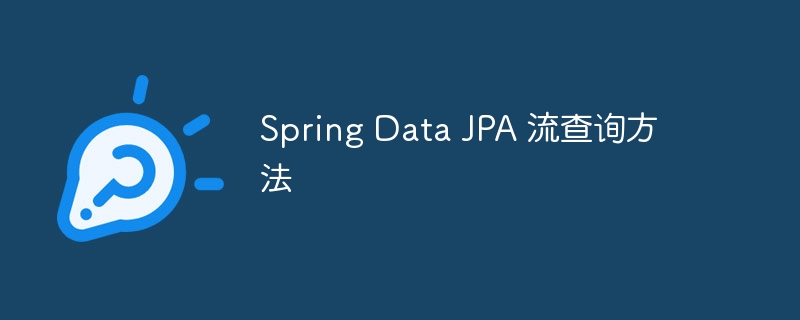◎欢迎参与讨论,请在这里发表您的看法、交流您的观点。
Spring Data JPA 流查询方法
ID:19137 / 打印
介绍
传统上,获取大量数据可能会导致内存资源紧张,因为它通常涉及将整个结果集加载到内存中。
=> 流查询方法通过提供一种使用 java 8 streams 增量处理数据的方法来提供解决方案。这可确保任何时候只有一部分数据保存在内存中,增强性能和可扩展性。
在这篇博文中,我们将深入研究流查询方法在 spring data jpa 中的工作原理,探索它们的用例,并演示它们的实现。对于本指南,我们使用:
- ide:intellij idea(推荐用于 spring 应用程序)或 eclipse
- java 版本:17
- spring data jpa 版本:2.7.x 或更高版本(与 spring boot 3.x 兼容)
<dependency> <groupid>org.springframework.boot</groupid> <artifactid>spring-boot-starter-data-jpa</artifactid> </dependency>
1.什么是流查询方式?
spring data jpa 中的流查询方法允许我们以 stream 的形式返回查询结果,而不是 list 或其他集合类型。这种方法有几个好处:
-
高效的资源管理:增量处理数据,减少内存开销。
-
延迟处理:按需获取和处理结果,非常适合分页或批处理等场景。
-
与函数式编程集成:流符合 java 的函数式编程特性,支持过滤、映射和收集等操作。
=> 假设我们正在开发一个电子商务应用程序并希望:
- 检索在特定日期之后下订单的所有客户。
- 过滤总金额高于特定提供金额的订单。
- 按过去 6 个月内的订单总价值对客户进行分组。
- 返回数据作为客户名称及其总订单价值的摘要。
实体
- 客户:代表客户。
@setter @getter @entity @entity(name = "tbl_customer") public class customer { @id @generatedvalue(strategy = generationtype.identity) private long id; private string name; private string email; @onetomany(mappedby = "customer", cascade = cascadetype.all, fetch = fetchtype.lazy) private list<order> orders; } - 订单:代表客户下的订单。
@setter @getter @entity(name = "tbl_order") public class order { @id @generatedvalue(strategy = generationtype.identity) private long id; private double amount; private localdatetime orderdate; @manytoone @joincolumn(name = "customer_id") private customer customer; } 存储库
- customerrepository 用于选择客户及其在特定日期之后下的相关订单。我们使用 stream
public interface customerrepository extends jparepository<customer, long> { @query(""" select c from tbl_customer c join fetch c.orders o where o.orderdate >= :startdate """) @queryhints( @queryhint(name = availablehints.hint_fetch_size, value = "25") ) stream<customer> findcustomerwithorders(@param("startdate") localdatetime startdate); }
- join fetch 确保订单被急切加载。
- @queryhints 用于向 jpa(例如 hibernate)提供额外提示以优化查询执行。
- 前 25 条记录由应用程序获取并处理。
- 处理完这些后,将获取接下来的 25 条记录,依此类推,直到处理完所有 100 条记录。
- 此行为最大限度地减少了内存使用量,并避免一次将所有 100 条记录加载到内存中。
服务
@service @requiredargsconstructor public class customerorderservice { private final customerrepository customerrepository; @transactional(readonly = true) public map<string, double> getcustomerordersummary(localdatetime startdate, double minorderamount) { try (stream<customer> customerstream = customerrepository.findcustomerwithorders(startdate)) { return customerstream // filter customers with orders above the threshold .flatmap(customer -> customer.getorders().stream() .filter(order -> order.getamount() >= minorderamount) .map(order -> new abstractmap.simpleentry<>(customer.getname(), order.getamount()))) // group by customer name and sum order amounts .collect(collectors.groupingby( abstractmap.simpleentry::getkey, collectors.summingdouble(abstractmap.simpleentry::getvalue) )); } } }
控制器
@restcontroller @requestmapping("/customers") @requiredargsconstructor public class customerordercontroller { private final customerorderservice customerorderservice; @getmapping("/orders") public responseentity<map<string, double>> getcustomerordersummary( @requestparam @datetimeformat(iso = datetimeformat.iso.date_time) localdatetime startdate, @requestparam double minorderamount ) { map<string, double> ordersummary = customerorderservice.getcustomerordersummary(startdate, minorderamount); return responseentity.ok(ordersummary); } } 测试
=> 要创建测试数据,您可以在我的源代码中执行以下脚本或自己添加。
src/main/resources/dummy-data.sql
请求:
- 开始日期: 2024-05-01t00:00:00
- 最小订单金额:100
curl --location 'http://localhost:8090/customers/orders?startdate=2024-05-01t00%3a00%3a00&minorderamount=100'
- 返回总金额等于或大于 minorderamount 的所有客户。
{ "Jane Roe": 500.0, "John Doe": 150.0, "Bob Brown": 350.0, "Alice Smith": 520.0 } => 您可以使用 intellij profiler 监控内存使用情况和执行时间。有关如何添加和测试大数据集的更多详细信息,您可以在我的 github 存储库中找到
小数据集:(10 个客户,100 个订单)
- 流:执行时间(~5ms),内存使用(低)
- 列表:执行时间(~4ms),内存使用(低)
大型数据集(10.000 个客户,100.000 个订单)
- 流:执行时间(~202ms),内存使用(中等)
- 列表:执行时间(~176ms),内存使用(高)
性能指标
| metric | stream | list |
|---|---|---|
| initial fetch time | slightly slower (due to lazy loading) | faster (all at once) |
| memory consumption | low (incremental processing) | high (entire dataset in memory) |
| memory consumption | low (incremental processing) | high (entire dataset in memory) |
| processing overhead | efficient for large datasets | may cause memory issues for large datasets |
| batch fetching | supported (with fetch size) | not applicable |
| error recovery | graceful with early termination | limited, as data is preloaded |
spring data jpa 流查询方法提供了一种优雅的方式来高效处理大型数据集,同时利用 java streams 的强大功能。通过增量处理数据,它们减少了内存消耗并与现代函数式编程范例无缝集成。
您对流查询方法有何看法?在下面的评论中分享您的经验和用例!
下一篇文章见。快乐编码!
